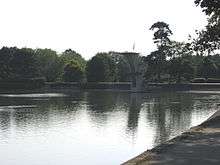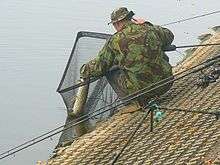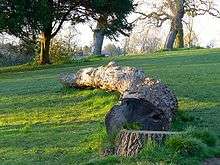Coate Water Country Park
Coate Water (grid reference SU177827) is a country park situated 5 km (3.1 mi) to the southeast of central Swindon, England, near junction 15 of the M4. It takes its name from its main feature, a reservoir originally built to provide water for the Wilts & Berks Canal.


The reservoir formed a 70-acre (280,000 m2) lake, built in 1822 by diverting the River Cole. Its primary purpose was to provide water for the canal and it remained outside the borough of Swindon until the borough's expansion in 1928.[1]
In 1914, with the canal abandoned, Coate became a pleasure park; changing rooms and a wooden diving board were added. In 1935 the wooden diving platform was replaced with a 33 ft (10 m) high concrete platform in an Art Deco style which has been praised by English Heritage and, although swimming in the lake has been prohibited since 1958, it was given Grade II listed protection in 2013.[2] Now named Coate Water Country Park, the lake is both a leisure facility and a nature reserve.
Development

In 2004, Swindon Borough Council and the University of Bath published plans to develop land next to the park as a campus, but the university later withdrew the proposals. Since then Persimmon Homes and Redrow Homes have submitted various planning applications. One was turned down and dismissed at a planning appeal. Another proposal for 900 houses and an industrial estate went to appeal in November 2011 and was allowed by the Secretary of State. Local residents began a Save Coate campaign, which drew attention to archaeological features[3] and pointed out that development conflicts with several of Swindon Borough Council's environmental policies.[4]
A buffer zone around the park was proposed in late 2006,[5] although campaigners and local residents did not think this was enough. In a newspaper poll, 20 per cent of readers said they believed that the new plans would help to protect Coate Water.[5] The issue was further compounded when Coate Water was voted "Swindon's Favourite Place" by the local population.[6]
Archaeology
The area has Mesolithic, Neolithic, Bronze Age, Iron Age, Romano-British and Medieval history that spans a period of 7000 years or more.
The oldest known ancient monuments at Coate are the undated stone circle and the Bronze Age burial mounds along Day House Lane. Further Middle Bronze Age cremations, a possible pond barrow, and two large ring ditches have been found on the opposite side of the small Day Brook valley. A large, regionally significant Mesolithic flint scatter, with some topologically late artifacts, is also present c.150m south west of Coate Stone Circle. Six stone circles were recorded in the 18th/19th and early 20th centuries, all in the Coate area, and possibly linked, at least in part, by avenues of large sarsen stones. The remains of one of the stone circles probably still lies at the bottom of the lake at Coate Water. Other relevant archaeology listed on the Sites and Monuments Records includes the Coate Mound, excavated with very little record in the earlier 20th c, which is spatially associated with the Mesolithic artifact scatter.
Other ancient finds and sites occur in the area south to Badbury Wick, and across the Day Brook valley, in later periods. This includes obscure Neolithic activity, Middle Bronze Age farming, a Mid-late Bronze Age enclosed settlement at Badbury Wick, unenclosed Middle Iron Age buildings, a small Roman settlement, and a deserted medieval village.
Ecology

An area of 51.1 hectares of the lake and its margins has been notified as a biological Site of Special Scientific Interest, mainly for its breeding bird populations.[7][8] Part of the site is also a local nature reserve.[9][10]
Coate Water is a notable site for birds. The following rare-in-Wiltshire species have been recorded there:
- Bearded tit – a pair in October 1982[11]
- Black-crowned night heron – adults in April 1978 and May 1990[12]
- Black-throated diver – a non-breeding plumaged adult in February 1978[13]
- Black Swan - one in February 2018
- Eurasian spoonbill – two adults in April 1978[14]
- European shag – one in September 1993[15]
- Grey phalarope – two juveniles in October 1987[16]
- Little auk – one in January 1984[17]
- Northern fulmar – one in June 1978[18]
- Purple heron – a first-summer bird in May 1981[18]
- Red-necked grebe – an adult in March/April 1995[19]
- Red-throated diver – a juvenile in March 1979[20]
- Ring-necked duck – a first-winter male in January 1998[21]
- Rock pipit – one in March 1976[22]
- Slavonian grebe – one in January 1982[23]
- Warblers
- Barred warbler – one in September 1980[24]
- Savi's warbler – one in May 1965[25]
- Yellow-browed warbler – one in September 1988[26]
Activities
Organisations based at the lake include Swindon Rowing Club[27] and Coate Water Sailing Trust.[28]
The North Wilts Model Engineering Society have a miniature railway, with about one mile of track of 5 in (127 mm) and 7 1⁄4 in (184 mm) gauge.[29]
In fiction
Author Richard Jefferies (1848–1887) was born at Coate village, a short distance northeast of Coate Water in Chiseldon parish; his home is now a museum. The "New Sea" in his Bevis books was based on Coate Water.
References
- Mark Child (2002). Swindon : An Illustrated History. United Kingdom: Breedon Books Publishing. ISBN 1-85983-322-5.
- Historic England. "Coate Water Diving Platform (1417099)". National Heritage List for England. Retrieved 22 November 2015.
- "Campaigners call for conservation area at Coate". Save Coate. Archived from the original on 2007-02-19. Retrieved 2007-01-30.
- "What Else is Wrong with the Plan?". Save Coate. Archived from the original on 2007-10-01. Retrieved 2007-01-30.
- Anthony Osborne (2006). "'Coate Water buffer zone is in wrong place'". Swindon Advertiser. Retrieved 2007-01-30.
- "Swindon's Favourite Place". Swindon Report. swindonweb.com. 2003. Archived from the original on 2006-08-18. Retrieved 2007-01-30.
- "Coate Water citation" (PDF). Sites of Special Scientific Interest. Natural England. Archived from the original (PDF) on 2012-10-24.
- "Map of Coate Water". Sites of Special Scientific Interest. Natural England.
- "Coate Water". Local Nature Reserves. Natural England.
- "Map of Coate Water". Local Nature Reserves. Natural England.
- Wiltshire Ornithological Society (2007), Birds of Wiltshire, page 623-4
- Wiltshire Ornithological Society (2007), Birds of Wiltshire, page 249-50
- Wiltshire Ornithological Society (2007), Birds of Wiltshire, page 227
- Wiltshire Ornithological Society (2007), Birds of Wiltshire, page 260
- Wiltshire Ornithological Society (2007), Birds of Wiltshire, page 246-7
- Wiltshire Ornithological Society (2007), Birds of Wiltshire, page 394-5
- Wiltshire Ornithological Society (2007), Birds of Wiltshire, page 438-9
- Wiltshire Ornithological Society (2007), Birds of Wiltshire, page 237-8
- Wiltshire Ornithological Society (2007), Birds of Wiltshire, page 235
- Wiltshire Ornithological Society (2007), Birds of Wiltshire, page 226
- Wiltshire Ornithological Society (2007), Birds of Wiltshire, page 192
- Wiltshire Ornithological Society (2007), Birds of Wiltshire, page 526-7
- Wiltshire Ornithological Society (2007), Birds of Wiltshire, page 236
- Wiltshire Ornithological Society (2007), Birds of Wiltshire, page 597
- Wiltshire Ornithological Society (2007), Birds of Wiltshire, page 583-4
- Wiltshire Ornithological Society (2007), Birds of Wiltshire, page 605
- "Swindon RC". British Rowing. Retrieved 12 April 2017.
- Sauvebois, Marion (30 April 2015). "CLUB OF THE WEEK: Sail away with us". Swindon Advertiser. Retrieved 12 April 2017.
- Jones, Paul (18 June 2015). "Coate Water railway marks 50 years of rides". Swindon Advertiser. Retrieved 12 April 2017.
Bibliography
- Wiltshire Ornithological Society (2007) Birds of Wiltshire ISBN 978-0-9555270-0-5
External links
| Wikimedia Commons has media related to Coate Water Country Park. |
- Coate Water – Swindon Council's guide to the country park
- coatewater.com – Information and Forum
- Richard Jefferies Museum
- Swindon advertiser – 2008 non-development campaign
- Coate Water Miniature Railway